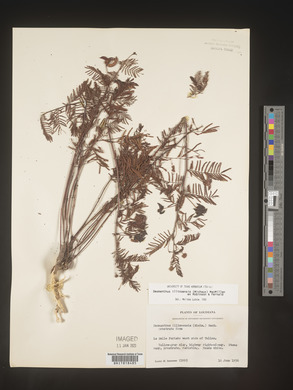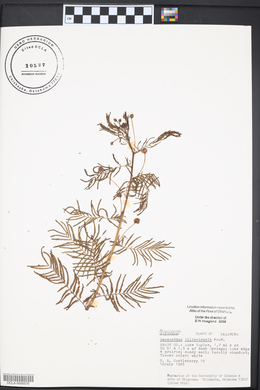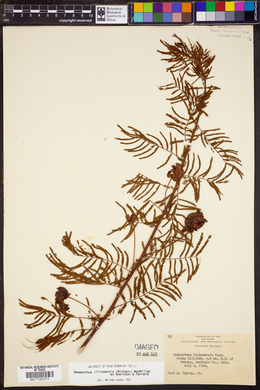Desmanthus illinoensis
|
|
|
|
Family: Fabaceae
Prairie Bundle-Flower
[Acuan illinoense, moreAcuan illinoensis (Michx.) Kuntze, Darlingtonia intermedia , Desmanthus brachylobus , Desmanthus falcatus Scheele, Mimosa illinoensis Michx.] |
Taprooted herb with clustered stems to 1 m or more; stipules filiform, 6-10 mm; lvs bipinnate, 5-10 cm, nearly sessile; pinnae 6-12 pairs, 2-4 cm; lfls 20-30 pairs, 1.5-3 mm, often ciliate; peduncles 2-6 cm, ascending; pet 2 mm; stamens 5; frs strongly curved or somewhat twisted together into a dense subglobose head, thin, 1-2.5 cm נ4-7 mm; seeds 3-5 mm, nearly as wide; 2n=28. Moist or dry soil, riverbanks, prairies, and pastures; O. to N.D., s. to Fla. and N.M., and occasionally intr. elsewhere. All summer. (Acuan i.) Gleason, Henry A. & Cronquist, Arthur J. 1991. Manual of vascular plants of northeastern United States and adjacent Canada. lxxv + 910 pp. ©The New York Botanical Garden. All rights reserved. Used by permission. Correll and Johnston 1970, Allred and Ivey 2012, Martin and Hutchins 1980 Duration: Perennial Nativity: Native Lifeform: Forb/Herb General: Perennial herb, 30-100 cm tall, from a slightly woody root crown; stems several from the crown, ascending or erect. Leaves: Alternate and pinnately twice-compound, with 6-14 pairs of primary pinnae, each of those with many tiny leaflets; leaflets linear, 2-3 mm long, with pointed (acute) tips. Entire leaf is 6-10 cm long. Flowers: Whitish and showy, in dense globose clusters at the ends of long axillary peduncles, these 3-7 cm long; flowers have 5 small sepals, 5 small petals, and 5 stamens that are much longer than the petals and sepals. Fruits: Legumes flat, crescent-moon shaped, 15-25 mm long and 5 mm wide, glabrous; clustered in dense heads at the ends of axillary peduncles; legumes split open promptly upon maturity to release several seeds. Ecology: Found along watercourses, ditches, roadsides, and in grasslands; from 3,000-6,500 ft in the Southwest; flowers June-August. Distribution: OH to SD, south to FL, TX, and NM. Notes: This erect perennial is common throughout the southern Great Plains, especially along roadsides as it prefers open, sunny locations. It is closely related to Mimosa and Acacia, and as such has bipinnately compound leaves; white, puffball-like flower clusters; and flat, brown, crescent-shaped seed pods. The seed pods are perhaps the most distinctive part of this plant, as they are in such dense rounded clusters near the tops of the stems. There are several other species of Desmanthus in the Southwest, but this is the only one with crescent-shaped seed pods; the other species have straight, linear seed pods. Ethnobotany: The roots are said to contain DMT and used with other plants to create a hallucinogenic mixture called prairie-huasca; the seeds are edible; a decoction of the leaves was used as a wash on itches. Etymology: Desmanthus translates to bundle-flower, from the Greek desme, bundle, and anthos, flower; illinoensis means of or from Illinois. Synonyms: Acuan illinoense Editor: AHazelton 2017 From Flora of Indiana (1940) by Charles C. Deam I believe this species was introduced into Indiana from the west. It was first reported in 1878 from Clark County by Baird & Taylor who lived at Jeffersonville, but McMurtrie, who published a flora of the vicinity of Louisville in 1819, and Clapp, who worked intensively the area about New Albany, did not report it. It was not reported from Ohio until about 1900. Short, Peter, & Griswold did not report it from Kentucky. Riddell, who published in 1835, reports it from Kentucky on the authority of Eaton and from the area west of Indiana. Our second published record is dated in 1924. I found it, however, along a railroad in Daviess County in 1910 and along a roadside south of Charlestown in 1915. I have seen it as an abundant plant about ferries and on the rocky slopes of the bank of the Ohio River in Dearborn, Jefferson, and Perry Counties. It has been reported also from Lake, Montgomery, Putnam, and Washington Counties. Its preferred habitat seems to be rocky slopes of banks, embankments of railroads, and prairies. ...... Indiana Coefficient of Conservatism: C = 3 Wetland Indicator Status: FACU |
|
|
|

























































































